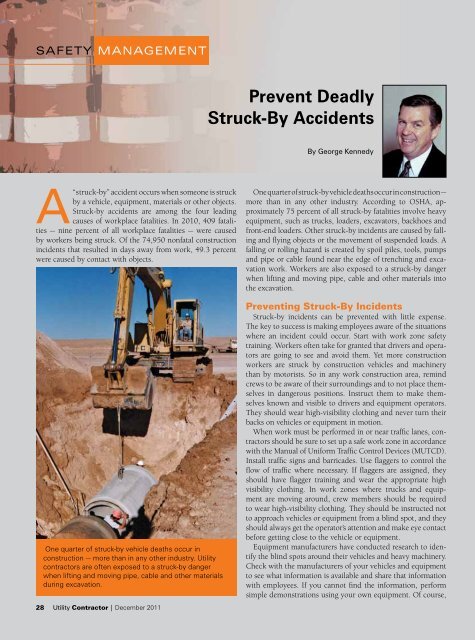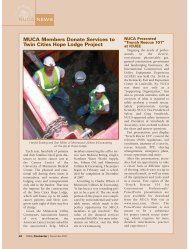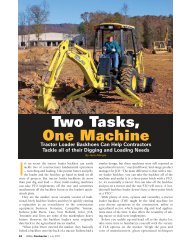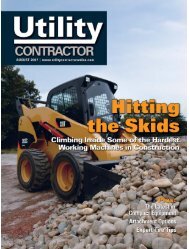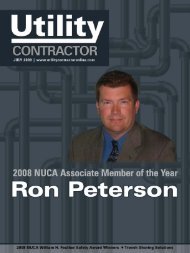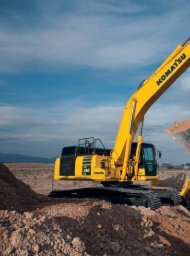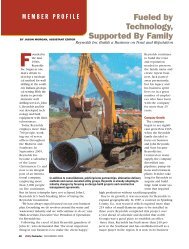View Full December PDF Issue - Utility Contractor Online
View Full December PDF Issue - Utility Contractor Online
View Full December PDF Issue - Utility Contractor Online
You also want an ePaper? Increase the reach of your titles
YUMPU automatically turns print PDFs into web optimized ePapers that Google loves.
N<br />
safety management<br />
Prevent Deadly<br />
Struck-By Accidents<br />
By George Kennedy<br />
A<br />
“struck-by” accident occurs when someone is struck<br />
by a vehicle, equipment, materials or other objects.<br />
Struck-by accidents are among the four leading<br />
causes of workplace fatalities. In 2010, 409 fatalities<br />
— nine percent of all workplace fatalities — were caused<br />
by workers being struck. Of the 74,950 nonfatal construction<br />
incidents that resulted in days away from work, 49.3 percent<br />
were caused by contact with objects.<br />
One quarter of struck-by vehicle deaths occur in<br />
construction — more than in any other industry. <strong>Utility</strong><br />
contractors are often exposed to a struck-by danger<br />
when lifting and moving pipe, cable and other materials<br />
during excavation.<br />
28 <strong>Utility</strong> <strong>Contractor</strong> | <strong>December</strong> 2011<br />
One quarter of struck-by vehicle deaths occur in construction —<br />
more than in any other industry. According to OSHA, approximately<br />
75 percent of all struck-by fatalities involve heavy<br />
equipment, such as trucks, loaders, excavators, backhoes and<br />
front-end loaders. Other struck-by incidents are caused by falling<br />
and flying objects or the movement of suspended loads. A<br />
falling or rolling hazard is created by spoil piles, tools, pumps<br />
and pipe or cable found near the edge of trenching and excavation<br />
work. Workers are also exposed to a struck-by danger<br />
when lifting and moving pipe, cable and other materials into<br />
the excavation.<br />
Preventing Struck-By Incidents<br />
Struck-by incidents can be prevented with little expense.<br />
The key to success is making employees aware of the situations<br />
where an incident could occur. Start with work zone safety<br />
training. Workers often take for granted that drivers and operators<br />
are going to see and avoid them. Yet more construction<br />
workers are struck by construction vehicles and machinery<br />
than by motorists. So in any work construction area, remind<br />
crews to be aware of their surroundings and to not place themselves<br />
in dangerous positions. Instruct them to make themselves<br />
known and visible to drivers and equipment operators.<br />
They should wear high-visibility clothing and never turn their<br />
backs on vehicles or equipment in motion.<br />
When work must be performed in or near traffic lanes, contractors<br />
should be sure to set up a safe work zone in accordance<br />
with the Manual of Uniform Traffic Control Devices (MUTCD).<br />
Install traffic signs and barricades. Use flaggers to control the<br />
flow of traffic where necessary. If flaggers are assigned, they<br />
should have flagger training and wear the appropriate high<br />
visibility clothing. In work zones where trucks and equipment<br />
are moving around, crew members should be required<br />
to wear high-visibility clothing. They should be instructed not<br />
to approach vehicles or equipment from a blind spot, and they<br />
should always get the operator’s attention and make eye contact<br />
before getting close to the vehicle or equipment.<br />
Equipment manufacturers have conducted research to identify<br />
the blind spots around their vehicles and heavy machinery.<br />
Check with the manufacturers of your vehicles and equipment<br />
to see what information is available and share that information<br />
with employees. If you cannot find the information, perform<br />
simple demonstrations using your own equipment. Of course,


